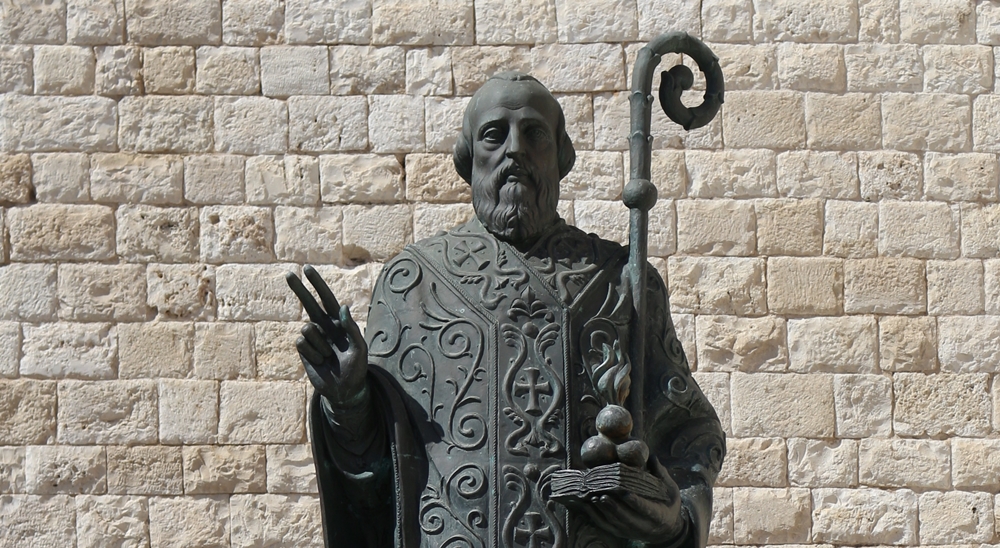
Detail of the bronze statue of St. Nicholas, XXIst century, churchyard of the St. Nicholas Basilica, Bari
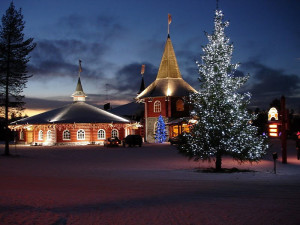
Lapland – View of the Santa Claus Village, Rovaniemi – Ph. Tarja Mitrovic | CCBY2.0
Let’s move for a moment in Northern Europe, in the Arctic snows of Rovaniemi, the capital of Lapland, in the far north of Finland, on the trail of a man whose name has been travelling hundreds of thousands of miles around the world for almost 1000 years. Not far from this small town of North Pole is the famous Santa Claus Village, visited each year by tourists from all over the world as well as the final destination of thousands of letters that children send from every corner of the planet in the hope that the Great Old with the sled and the sack of gifts over his shoulder will grant their wishes at Christmas. He is there, in the flesh, receiving guests while dozens of elves help him to manage the intense correspondence if they are not in their secret laboratory. That would seems the beginning of an all Nordic fairy tale conceived during a cold winter night by a Lapp storyteller, whereas it is just the final development of a story born in the waves of the Mediterranean sea, under the sun of the deep Southern Europe: in Italy.
Scene change. We are in Bari, an Apulian city overlooking the Adriatic sea, that same sea through which, on May 9, 1087, on a caravel 62 sailors brought the bones of the Turkish Bishop Nicholas of Myra, who lived from 270 to 343 AD, and whose new homeland changed his name into St. Nicholas of Bari, the Italian city where his remains now rest venerated by Catholic, Orthodox, and many other Christian denominations. This southern city would be the starting point of his long journey towards a universal reputation as he is now on the altars of the rest of Italy as well as of places like Spain, Portugal, France, Germany, Holland, Romania, Denmark, Iceland, Sweden, Russia, England, the United States, Canada, Asia, Africa, and Australia. Being considered the patron saint of sailors, Nicholas has landed in every ‘port’, thus becoming the most popular saint of Christianity.
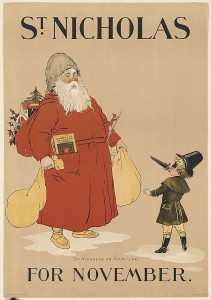
“St Nicholas or your life!”: an ironic American illustration of 1895, showing the already occurred metamorphosis of St. Nicholas in Santa Claus – Ph. Boston Public Library | CCBY2.0
However, in those same places, at some point, appeared the figure that, to some extent, we can consider the stunt of St. Nicholas: Santa Claus (Anglo-Saxon metamorphosis for Sinterklaas or Sint Nicolaas, as he is called in the Netherlands), for Italians Babbo Natale [literally, Father Christmas, NdT]. It is now certain that the figure of the bearded old man wearing red pants and a white-fur-trimmed red jacket – this outfit being based on older depictions of St. Nicholas dressed in red but with the bishop features still clearly shown (like in the Dutch Sinterklaas) – was conceived by the New Yorker writer and linguist Clement Clarke Moore, who wrote the poem A Visit from Saint Nicholas in 1823, and described him as a chubby elf with a white beard, red clothes, driving a sleigh pulled by reindeers and charged with lots of toys.
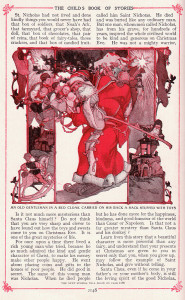
“Santa Claus, The True Story of Father Christmas”: an American publication of 1912, which reveals the connection between Santa Claus and Saint Nicholas
Afterwards, at Christmas 1862, the illustrator Thomas Nast depicted Santa Claus with a red jacket, a white beard and boots on the US magazine “Harper’s Weekly”. That image would soon be used for ads, as in the early ’30s Coca-cola did using Haddon Sundblom’s doubtless most famous, even though not first, illustration. The modern image of Santa Claus was so born, a mix of some north European pagan folk motifs, and southern stories about St. Nicholas’ life.
At this point, one could wonder how the figures of St. Nicholas and Santa Claus, the bearer of gifts to children, are connected to each other. In order to answer this question, it is necessary to return once again in Bari, in southern Italy. Until not long ago, the inhabitants of the Adriatic city were carrying on the widespread tradition of St. Nicholas bringing gifts to good children during the night of 5 to 6 December (anniversary of his death); this tradition is similar to the one still preserved today in the Netherlands, where the Saint arrives accompanied by his donkey or a horse (and not by a reindeer), and gives candies to the children who sing “The lament of St. Nicholas.” Something similar survives also in Romania, where in the evening of 5 December, children put their accurately polished shoes out their door, and wait for Nicholas to fill them up with gifts over the night. In almost all countries, however, this tradition has been moved to the night of Christmas Eve.
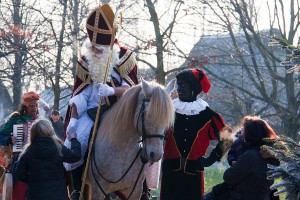
Sinterklaas, the Dutch version of Santa Claus: St. Nicholas is still recognizable, thanks to the bishop’s miter and pastoral staff. He travels on horseback and is accompanied by Zwarte Piet, a Moor page with colored clothes; actually he is a demon submissive to the will of the Saint – Ph. Hans Splinter | CCBY-ND2.0
However, if in northern Europe Saint Nicolas distributes gifts as other figures from the local folklore do, for Italians he does that exclusively because he is a very generous person. Some of his biographies describe him as particularly kind to poor people, and especially to children. Two episodes have become legendary: the first tells that one night he gave three bags full of gold to a poor man who was about to start his three young daughters into prostitution as he could not marry them decently, and the second tells that he resurrected three children that an evil landlord had killed and placed in salt to sell their meat.
It is impressive to note how many stories, ideas, and symbols are stratified, and lie behind the figure that today has become the star of a strongly business-connoted phenomenon. Therefore, in order to trace the ‘southern’ origins of the myth of Santa Claus, a backward path has to be followed. It is a myth that many people still look at as the result of a Nordic fairy tale for children, while in fact it hides a historical figure – San Nicola of Myra – whose only true “home” has been for 927 years in Bari, Italy, even though he has been citizen of world since time immemorial. This is witnessed by the numerous churches dedicated to him in all continents (only in Italy, there are about 300.) Tracing the true source of the myth of Santa Claus wants therefore to be a way to rediscover a heritage of faith and traditions that can give a deeper meaning to the profane “fairy tale”, and to find out that at the end of the journey there is not a house in the snows of the far North, but a splendid church of Apulia on the shores of the Mediterranean sea.
© ALL RIGHTS RESERVED
ICONOGRAPHY OF ST. NICHOLAS BETWEEN SACRED AND PROFANE
 Fame di Sud Il sud Italia come non lo avete mai visto
Fame di Sud Il sud Italia come non lo avete mai visto


